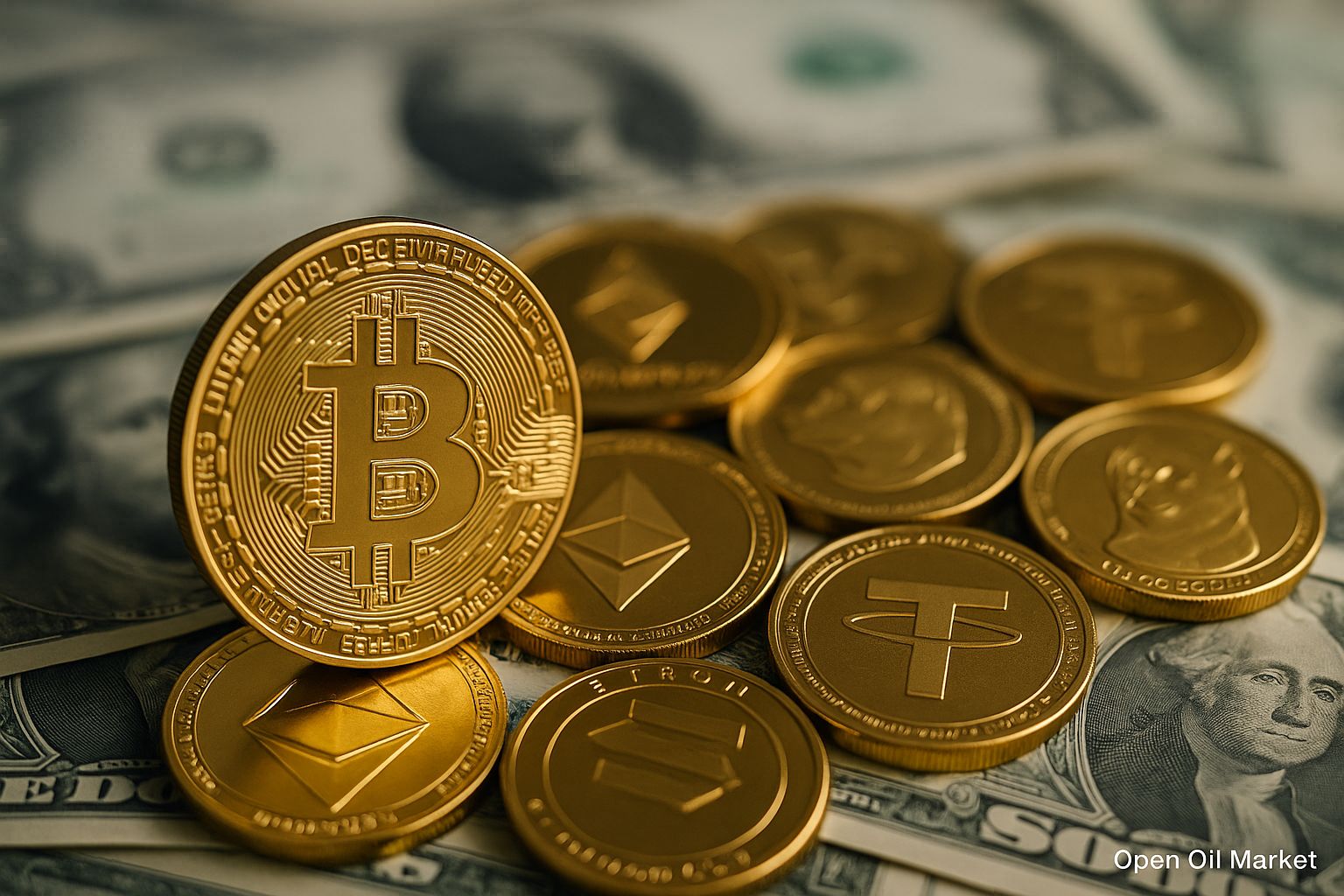
Latest Cryptocurrency News for October 17, 2025: Bitcoin Stabilizes, Ethereum Recovers, Altcoins Rise. Top 10 Coins, Key Market Events, and Analysis for Investors.
As of the morning of October 17, 2025, the cryptocurrency market is showing moderate growth following a recent spike in volatility. Bitcoin holds above the $110,000 mark and is looking to test the $120,000 level, supporting the recovery of the overall cryptocurrency market capitalization (now back above $3 trillion). Following Bitcoin, Ethereum and most leading altcoins are consolidating gains: the top 10 digital assets are trading in the "green zone." Investors, including institutional players, are gradually returning to the market amid improving sentiment, persistent interest in crypto ETFs, and a favorable regulatory environment.
The Market Resumes Growth After Correction
After a sharp decline in prices last week (the so-called "flash crash" of October 10-11), the cryptocurrency market stabilized and began to recover. Within days, the excessive panic subsided: the total market value of crypto assets has regained a significant portion of its losses. Bitcoin, which briefly fell below $110,000, has risen again, pulling the rest of the market along. Volatility remains elevated by historical standards, yet is notably lower than last week's peak levels. The "fear and greed" index, which fell into the fear zone during the crash, has returned closer to greed mode, reflecting a cautious optimism among market participants. Marginal position liquidation volumes have also decreased to average levels: after record liquidations of approximately $19 billion during the sell-off, recent days have seen liquidations measured only in the hundreds of millions, indicating a lessening of market tension.
Key Market Indicators:
- Cryptocurrency market capitalization: ≈ $3.5 trillion
- Bitcoin market share: ~60%
- Fear and greed index: 60 (greed)
Bitcoin Targets New Highs
The market leader, Bitcoin (BTC), is consolidating around the $118,000 mark and is close to a key resistance level near $120,000. The current price is only a few percentage points below the historical peak (~$124,000), reached earlier in October. Despite the recent correction, Bitcoin has gained around 45-50% since the beginning of the year, once again outpacing traditional assets (stock indices, gold) and affirming its status as "digital gold" for long-term investors. The market capitalization of BTC now exceeds $2.3 trillion, accounting for more than half of the total cryptocurrency market. Experts note that Bitcoin's confident recovery after the decline has bolstered market participants' trust: many view the recent drop as a technical breather within an ongoing bullish trend.
Additional support for Bitcoin comes from the inflow of institutional capital. The launch of the first spot Bitcoin ETF in the U.S. (by BlackRock) at the beginning of the month attracted over $1.5 billion in investments within just a couple of weeks, demonstrating strong appetite from large players. Individual public companies have also capitalized on lower prices: for instance, mining firm Marathon Digital Holdings reported purchasing ~400 BTC last week, which served as a vote of confidence for the market. Stabilization is observed on derivative exchanges: open interest in BTC futures hovers around $25 billion, while increased demand for call options indicates expectations of further growth. Together, these factors signify that Bitcoin retains its leadership and sets the tone for the rest of the market, continuing to serve as the main benchmark in the industry.
Ethereum and Leading Altcoins
The second-largest cryptocurrency asset, Ethereum (ETH), is also moving upwards confidently. The price of Ethereum has once again exceeded the psychologically significant level of $4,000 and currently hovers around $4,200, approximately 15% lower than its historical maximum ($4,890, reached in November 2021). The upward trend in ETH remains solid: Ethereum's market share is holding steady around 13% of the overall market capitalization, confirming its status as the largest altcoin. Demand for Ether is supported by its blockchain's key role in decentralized finance (DeFi) and NFTs. Investors are also encouraged by anticipated technological upgrades to the network aimed at increasing scalability and reducing fees, which will enhance Ethereum’s long-term appeal.
Among other leading coins, Binance Coin (BNB)—the native token of the largest cryptocurrency exchange, Binance—stands out. Currently, BNB trades near $1,200 per coin, slightly below its recent record (~$1,300). Despite the legal and regulatory challenges facing Binance, the BNB token remains in the top 5 due to its broad range of applications: it is used for fee payments, participating in new token launches, and various DeFi services within the Binance ecosystem. XRP, the token of the payment platform Ripple, continues to hold its position, trading around $2.60, having strengthened over the past year amid Ripple's legal victory over the SEC in the U.S. The legal clarity regarding XRP's status has restored investor confidence: with a market capitalization of ~$150 billion, XRP is once again among the largest cryptocurrencies, affirming its significance in the cross-border payments sector.
Altcoin Market: Solana, Cardano, and Others
The broader altcoin market is generally showing synchronized recovery alongside the market leaders. Solana (SOL), one of the fastest-growing blockchain platforms for smart contracts, is holding steady around $200. Just a week ago, SOL experienced a more profound decline than Bitcoin, but with the return of activity in DeFi applications on Solana, its price has rebounded. Interest in SOL is further fueled by rumors of a potential exchange-traded fund (ETF) linked to this asset in the U.S. The successful implementation of such an ETF would make Solana the first protocol after BTC and ETH to receive its own fund in the traditional market, a factor that is appealing to institutional investors. Additionally, the Solana ecosystem continues to grow—new DeFi projects and NFT marketplaces are emerging on the network, enhancing SOL's fundamental value.
Another noteworthy altcoin is Cardano (ADA), a smart-contract platform developed with a scientific approach. Currently, ADA is trading around $0.70, stabilizing after sharp fluctuations in recent months. Back in August, anticipation for the ETF launch had driven Cardano’s price close to $1 before it corrected. The Cardano project attracts investors with its long-term potential: the team consistently rolls out updates (e.g., the Hydra scaling protocol), and the extensive community actively supports the ecosystem. Many ADA holders believe that improvements in the network's technical capabilities and a possible launch of equity products based on Cardano could eventually elevate the coin to new heights.
Also remaining in the top 10 by market capitalization are diverse projects like Dogecoin and Tron. The meme cryptocurrency Dogecoin (DOGE), initially created as a joke, nevertheless holds a price around $0.20 even after a decline of more than 20% in early October. Community support and periodic attention from celebrities allow DOGE to maintain its position as one of the largest coins, though its volatility typically remains high. The blockchain platform Tron (TRX) trades close to $0.32; this project is particularly popular in Asia due to its focus on entertainment and Web3. Tron is also known for the significant portion of the stablecoin USDT that circulates on its network, while the staking of TRX attracts users seeking additional income. The presence of Dogecoin and Tron among market leaders highlights the diversity of the crypto sector: alongside technological platforms, investors appreciate niche assets that are community-focused and cater to specific applications.
Market Leaders: Top 10 Most Popular Cryptocurrencies
- Bitcoin (BTC) - the first and largest cryptocurrency, "digital gold." Price around $118,000; dominates the market and attracts both retail and institutional investors.
- Ethereum (ETH) - the second largest cryptocurrency asset, the primary platform for smart contracts and DeFi. Price around $4,200; supports the operation of hundreds of decentralized applications, actively evolving to enhance scalability.
- Tether (USDT) - the largest stablecoin, pegged to the US dollar 1:1. Trading at $1.00; serves as a key source of liquidity in the crypto market, facilitating settlements and exchanges between various assets.
- Binance Coin (BNB) - the exchange token of Binance and the native token of the BNB Chain. Trading at approximately $1,200; used for fee payments and access to Binance ecosystem services, remaining one of the most valuable altcoins.
- Ripple (XRP) - the cryptocurrency of the Ripple payment network for global transfers. Trading around $2.60; after successes in court, the token has regained investor trust and remains among the largest coins, focusing on fast and inexpensive transactions.
- USD Coin (USDC) - the second most important stablecoin from Circle. Price at $1.00; known for its high transparency of reserves and widely used by institutions and DeFi protocols for secure entry into digital assets.
- Solana (SOL) - a high-speed next-generation blockchain. Price around $200; the Solana ecosystem is recovering after a correction and continues to grow (DeFi, NFTs), with SOL once again attracting the attention of developers and investors.
- Cardano (ADA) - a smart contract platform developed with a scientific approach. Trading around $0.70; the project is continually updated (e.g., the Hydra scaling protocol), has a large community, and is viewed by investors as a promising asset.
- Dogecoin (DOGE) - the most famous meme cryptocurrency that has gone beyond a joke. Price around $0.20; supported by enthusiasts and periodically celebrities, stays volatile but remains among the top ten largest coins.
- Tron (TRX) - a blockchain platform focused on the entertainment industry and Web3. Price around $0.32; known for the integration of stablecoins (a significant share of USDT circulates on Tron) and staking opportunities, which help it maintain its position among leaders.
Institutional Investments: ETF Effect and Inflow of Capital
One of the main market drivers in 2025 has been the strengthening of institutional participation. A landmark event in early October—the launch of the spot Bitcoin ETF by BlackRock—instantly opened access to BTC for numerous large investors via familiar exchange instruments. In less than two weeks, the new fund attracted around $1.5 billion, highlighting high latent demand. Additionally, according to CoinShares, last week total investments in cryptocurrency investment products reached ~$3.17 billion—one of the record weekly figures in the industry's history. The lion's share was directed towards Bitcoin funds (~$2.67 billion), yet significant inflows were noted in altcoin funds (for instance, Solana attracted ~$93 million, while XRP saw ~$62 million in the week). These figures indicate that institutional investors are interested not only in BTC but also in other digital assets.
Participants in the traditional financial market continue to integrate more actively with the crypto industry. Several large management companies, including Fidelity and Invesco, are awaiting decisions on their applications for launching their own Bitcoin ETFs, as well as submitting new applications related to Ethereum and other top assets. In particular, the SEC is reviewing applications for spot ETFs linked to Ethereum, as well as individual initiatives to launch funds based on Solana and Cardano—something that seemed unthinkable not long ago. In addition to equity instruments, banks and payment corporations are also venturing into cryptocurrencies: Visa and Mastercard are expanding services for stablecoins and crypto payments, while several international banks are launching services for the custody and trading of digital assets for clients. The expansion of the product line (ETFs, trusts, custodial services) and such engagement by Wall Street with the crypto sector enhance market liquidity and bring it closer to maturity.
A sign of the convergence of cryptocurrencies with traditional finance has also been the intentions of some crypto companies to go public. Recently, it was announced that the Gemini exchange plans to conduct an IPO in 2026. If these plans come to fruition, it would mark the first public offering of a major crypto platform since Coinbase's listing in 2021. The appearance of crypto company stocks on traditional exchanges, coupled with the growing number of institutional investment products, strengthens trust in the industry among conservative investors. Overall, the inflow of "smart money" continues to rise, solidifying cryptocurrencies' status as a legitimate asset class.
Regulation and Security: New Rules and Growing Trust
The global regulatory environment for cryptocurrencies is gradually becoming clearer, which in the long run supports increased trust in the market. In the European Union, the comprehensive MiCA regulation is coming into force, aimed at establishing unified rules for the crypto industry and protecting investors. In the United Kingdom, authorities are working to create a regulatory framework for digital assets, striving to make the London financial center attractive for crypto businesses. In several other jurisdictions (e.g., UAE, Hong Kong), friendly crypto licensing regimes are being implemented: these regions aim to attract innovative companies and capital by offering clear operational rules. Although increased oversight imposes additional requirements on the industry—such as adherence to AML/KYC procedures, reporting, and licensing of exchanges—ultimately it enhances market transparency and participant security. Many analysts agree that more defined "rules of the game" could attract even more institutional investors who were previously wary of regulatory uncertainty.
Regulators are also paying increased attention to security and preventing illegal activities with cryptocurrencies. A notable recent precedent in the U.S.: the Department of Justice initiated the largest ever seizure of crypto assets, confiscating over 127,000 BTC (about $15 billion) as part of a case concerning international fraud. This example demonstrates the authorities' determination to combat crime in the digital currency space. Simultaneously, measures to prevent cyberattacks and hacking incidents are actively discussed worldwide: exchanges are strengthening security systems, and regulators are demanding stringent measures for the protection of client funds. While these steps may introduce additional checks and balances, they ultimately create a more reliable market infrastructure.
The industry itself is also learning from recent events and taking steps to bolster its reputation. Major players are willing to collectively take responsibility for the stability of the ecosystem. For example, Binance announced the creation of a special fund totaling $400 million for compensations to users affected by the sudden price drop in October. Of this amount, $300 million will be allocated for payments to retail traders (proportionate to their losses) and $100 million for preferential lending to institutional clients, to support their liquidity. This voluntary action by Binance aims to restore trust in the industry following a stressful event. Analysts view such initiatives as a sign of market maturation: large companies increasingly act proactively, striving to protect users and prevent systemic risks. In aggregate, the enhancement of regulatory oversight and responsible business actions make the crypto ecosystem more resilient and attractive for new participants.
Market Outlook: Moderate Optimism
Despite the recent turmoil, the long-term prospects for the cryptocurrency market remain positive. Most analysts note that fundamental factors—Bitcoin's limited supply, increasing institutional engagement, technological advancements in blockchain platforms—continue to support a bullish trend. Major financial institutions are revising their forecasts upwards. For instance, Standard Chartered Bank recently raised its price target for Bitcoin by the end of 2025 to $200,000 (previously anticipating $120,000 to $150,000), and for Ethereum—to ~$7,500. The bank's analysts cite the accelerating adoption of crypto assets by institutional investors and the diminishing BTC supply due to the 2024 halving. Several independent experts also believe that the current growth cycle has not yet peaked: forecasts of BTC prices reaching $180,000 to $200,000 and ETH prices between $8,000 and $10,000 over the coming year are being circulated, assuming there are no significant macroeconomic upheavals.
At the same time, the road to new records may be uneven. Following a powerful rally in mid-2025, the market could enter a phase of consolidation. In the coming weeks, price fluctuations and short-term corrections are not ruled out, as some investors may take profits while new participants accumulate positions on dips. Temporary pulls back may also occur due to external factors: for instance, tightening rhetoric from the Fed or escalating geopolitical conflicts could trigger a wave of risk asset sell-offs. Some analysts warn that, in a negative scenario, Bitcoin might retest support levels around $100,000 before continuing its upward trajectory. However, many view such dips as healthy occurrences for a maturing market.
Experts advise investors to maintain a balanced approach under these conditions. Even with a positive long-term outlook, managing risks is crucial: avoiding excessive leverage, diversifying portfolios, and being prepared for high volatility. Experience shows that periods of euphoria are often followed by cooling phases, which, however, lay the groundwork for new growth spurts. The history of previous cryptocurrency development cycles confirms that every significant correction in a bull market ultimately led to even more robust increases. If the current macroeconomic and regulatory trends persist, the cryptocurrency market has every chance of continuing to expand in the foreseeable future. Many participants anticipate new historical maxima for key digital assets in the second half of this year and into 2026. Thus, the overall trend remains upward, and short-term fluctuations are merely a natural part of the journey towards new heights.




